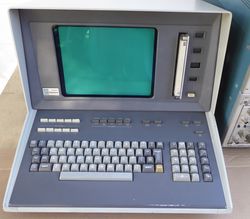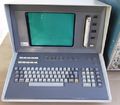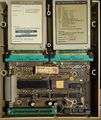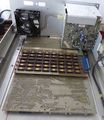4051: Difference between revisions
mNo edit summary |
ElectroRents (talk | contribs) mNo edit summary |
||
| Line 23: | Line 23: | ||
The remaining 32 kB of address space is reserved for ROM, which can be expanded using one or two external ROM cartridges of 8 kB each. The ROM includes six character sets and an extended dialect of BASIC including various vector drawing commands. | The remaining 32 kB of address space is reserved for ROM, which can be expanded using one or two external ROM cartridges of 8 kB each. The ROM includes six character sets and an extended dialect of BASIC including various vector drawing commands. | ||
'''Option 1''' adds a Data Communication Interface [[021-0188-00]] that attaches to the rear of the 4051 via a card-edge connector and provides an RS 232 port and two slots to accept expansion ROM cartridges/packs. | |||
The 4051 was released in 1975 for the base price of $5,995 (2020 value $28,960). Adding the optional RS-232 interface allowed it to emulate a Tektronix [[4012]] terminal. | The 4051 was released in 1975 for the base price of $5,995 (2020 value $28,960). Adding the optional RS-232 interface allowed it to emulate a Tektronix [[4012]] terminal. | ||
| Line 29: | Line 31: | ||
==See Also== | ==See Also== | ||
* [[021-0188-00]] '''Option 1''' Data Communication Interface | |||
* [[4050E01|4050E01 - ROM Expander]] | * [[4050E01|4050E01 - ROM Expander]] | ||
* [[4051R07|4051R07 - Signal Processing Cartridge Number 1]] | * [[4051R07|4051R07 - Signal Processing Cartridge Number 1]] | ||
Revision as of 13:48, 28 January 2022
The Tektronix 4051 is a graphics-capable desktop microcomputer produced by Tektronix in the late 1970s through the early 1980s. The display is similar to the Tektronix 4010 terminal, using a direct-view storage CRT display (like an analog storage scope) to avoid the need for video RAM.
An all-in-one design, the 4051 includes display, keyboard, CPU and a 300 kByte DC300 quarter-inch cartridge tape drive in a single desktop case, and includes a GPIB interface. A simple operating system and BASIC interpreter are stored in ROM.
The storage tube display allows the screen to retain images drawn to it, eliminating the need for frame-buffer memory, and allowing the resolution to be as high as the display hardware can handle - logical coordinates are 1024 by 1024 of which the physical screen displays 1024 by 780. This type of display does not require a raster buffer memory, so all memory can be dedicated to programs and data.
The 4051 is based on an 8-bit Motorola 6800 CPU running at 1 MHz, and normally shipped with 8 kB of RAM expandable to 32 kB using 8 kB modules.
The remaining 32 kB of address space is reserved for ROM, which can be expanded using one or two external ROM cartridges of 8 kB each. The ROM includes six character sets and an extended dialect of BASIC including various vector drawing commands.
Option 1 adds a Data Communication Interface 021-0188-00 that attaches to the rear of the 4051 via a card-edge connector and provides an RS 232 port and two slots to accept expansion ROM cartridges/packs.
The 4051 was released in 1975 for the base price of $5,995 (2020 value $28,960). Adding the optional RS-232 interface allowed it to emulate a Tektronix 4012 terminal.
Key designer of the 4051 was Hiro Moriyasu.
See Also
- 021-0188-00 Option 1 Data Communication Interface
- 4050E01 - ROM Expander
- 4051R07 - Signal Processing Cartridge Number 1
- 4051R08 - Signal Processing Cartridge Number 2
- 4907 "File Manager" floppy disk drive (GPIB)
- 4924 cartridge tape drive (GPIB)
Links
General Information
- Tektronix 4051 Brochure (PDF)
- Tektronix 4050 series at Wikipedia
- Tekscope 1975 Vol.7 No.5: A desk-top graphic computing system
- 4051 leaflet from 1976
Museums
Videos
- Tek 4051 at work @ YouTube
- 4051 introduction @ YouTube - part 1 / part 2 / part 3 / part 4 / part 5 / part 6 / Emulator
Software
- Tektronix 4051/4052/4054 Program Files (GitHub repository)
- 4051 firmware listings (microfiche scans) @ bitsavers
Pictures
-
Front view
-
Keyboard
-
4051 with 4924 GPIB cartridge tape drive
-
Back side
-
Back side detailed view
-
Back side detailed view
-
Communication Interface
-
Communication Interface
-
Communication Interface
-
Inside view
-
RAM board
-
main board
-
Screen without frame
-
Power supply
-
Power supply
-
ROMs closeup
-
4051 ad



















